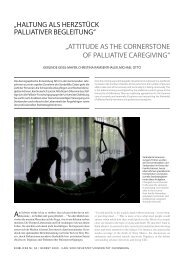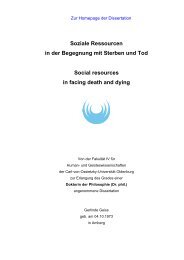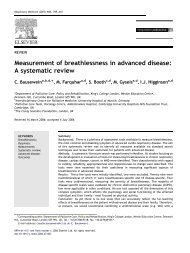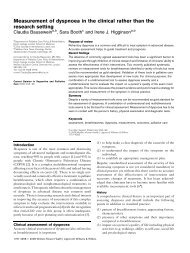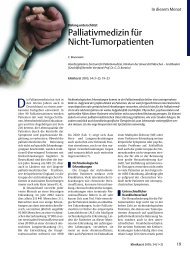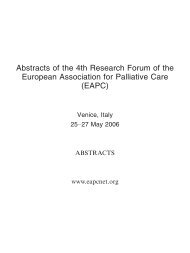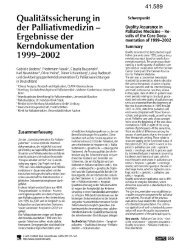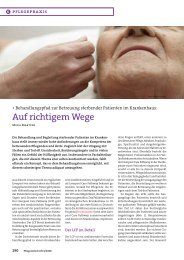EAPC - ipac
EAPC - ipac
EAPC - ipac
Create successful ePaper yourself
Turn your PDF publications into a flip-book with our unique Google optimized e-Paper software.
426 <strong>EAPC</strong> Abstracts<br />
palliative care is particularly limited. Conclusions: Hospice accessibility has<br />
implications for the establishment of further hospices and highlights the need<br />
to consider the remit of alternative palliative care services in areas without<br />
local access, as well as for deprived communities.<br />
89 Oral Presentation<br />
Organisation of Care and Services<br />
Improving generalist palliative care services for adults at the<br />
end of life: what more do we need to know<br />
Authors: Cathy Shipman Department of Palliative Care & Policy King’s<br />
College London UNITED KINGDOM<br />
Scott Murray University of Edinburgh Edinburgh UNITED KINGDOM<br />
Marjolein Gysels King’s College London London UNITED KINGDOM<br />
Sarah Forrest University of Cambridge Cambridge UNITED KINGDOM<br />
Stephen Barclay University of Cambridge Cambridge UNITED KINGDOM<br />
Patrick White King’s College London London UNITED KINGDOM<br />
Allison Worth University of Edinburgh Edinburgh UNITED KINGDOM<br />
Steve Dewar King’s Fund London UNITED KINGDOM<br />
Marilyn Peters King’s College London London UNITED KINGDOM<br />
Suzanne White King’s College London London UNITED KINGDOM<br />
Irene J Higginson King’s College London London UNITED KINGDOM<br />
Background: Most end of life care is provided at home, in care and nursing<br />
homes and hospital by generalists rather than specialists in palliative care.<br />
The importance of generalist care is recognised in current policy, but little is<br />
known about provision. The study aimed to identify issues, gaps in provision<br />
and research to improve generalist end of life care. Methods: A national consultation<br />
was undertaken in England and Scotland using a modified nominal<br />
group technique. 285 commissioners, generalist and specialist palliative care<br />
providers, academics, voluntary and user groups were invited to participate.<br />
Data was collected by email, face-to-face and telephone interview in 5 different<br />
areas, and a thematic analysis undertaken. Key priorities were agreed by<br />
participant votes. Results: 210 participants (74%) took part in the consultation<br />
across London, Cambridgeshire, Warwickshire and Scotland. There was<br />
little consensus about what constituted generalist end of life care. Perceived<br />
gaps in provision included care of non-cancer patients, older people and<br />
minority groups. We identified much enthusiasm for providing excellent end<br />
of life care, but engaging some generalists in education and training was difficult.<br />
A greater evidence base was needed for tools such as the Gold<br />
Standards Framework and Liverpool Care Pathway. Workforce and financial<br />
issues limited provision. More needed to be known about best practice, place<br />
of care and integrating end of life care into generalist caseloads.<br />
Understanding more about patient and carer experiences and health economic<br />
implications was central to generating a good evidence base. Conclusions:<br />
Generalist end of life care takes place in many different settings, amongst<br />
many competing priorities. Given its importance, lack of research to underpin<br />
best practice is surprising. Current policy developments in England are<br />
welcomed but need a strong evidence base to ensure sustainability. Funder:<br />
National Institute for Health Research SDO Programme, England.<br />
90 Oral Presentation<br />
Organisation of Care and Services<br />
Can we prevent emergency hospital admission of older people<br />
at the end of life Methodologies, challenges and findings from<br />
the first wave of data from the COPEC study<br />
Authors: Barbara Gomes Palliative Care, Policy & Rehabilitation Cicely<br />
Saunders International/King’s College Londo UNITED KINGDOM<br />
Rachel Burman King’s College Hospital NHS Trust London UNITED<br />
KINGDOM<br />
Andy Parfitt Guy’s & St Thomas’ NHS Foundation Trust London UNITED<br />
KINGDOM<br />
Irene J Higginson King’s College London, Department of Palliative Care,<br />
Policy & Rehabilitation London UNITED KINGDOM<br />
Ed Glucksman King’s College Hospital NHS Trust London UNITED<br />
KINGDOM<br />
Laura Skingle King’s College London, Department of Palliative Care,<br />
Policy & Rehabilitation London UNITED KINGDOM<br />
Teresa Beynon Guy’s & St Thomas’ NHS Foundation Trust London<br />
UNITED KINGDOM<br />
Background: Most older people die in hospital and numbers of 65’s and<br />
over (65+) at Emergency Departments (EDs) are increasing. COPEC study<br />
– Care for Older People in Emergency Care – aims to 1) describe<br />
reasons/patterns of admission for 65+ to two EDs in London 2) assess<br />
palliative need amongst the group 3) investigate whether admissions were<br />
preventable. Methods: Review of records of all patients 65+ who died/were<br />
admitted at EDs at King’s College Hospital or Guy’s and St Thomas’<br />
Hospital (Nov06–Oct07). The hospitals serve a population of 760,000,<br />
77,300 aged 65+. Data from 3 databases at each site were analysed to<br />
describe patient profile and reasons/patterns for death/admission. Review of<br />
case notes for a random sample will describe palliative need and assessed<br />
preventability of admissions. Results: In one year, there were 27,543 attendances<br />
of 65+ across the two EDs (11.7% of all ED attendances): 130 died<br />
at ED (46.3% of all ED deaths) and 51.9% were admitted (28.6% of all ED<br />
admissions). First phase findings at King’s College Hospital show that of<br />
those died/admitted, 48.0% came in out-of-hours (59.3% in weekdays,<br />
6pm-8am) and 45.1% presented alone. Problems most frequently recorded<br />
at ED were shortness of breath (12.1%), falls (10.5%) and chest pain<br />
(8.2%); diagnosis was unknown in 89.1% of cases. Approvals for use of<br />
data where patient consent was unfeasible took 5 months (40% of project<br />
time), granted by 4 organizations. Conclusions: Older people are frequent<br />
admitted at EDs and patterns suggest isolation and lack of alternatives<br />
during out of hours. Nearly half of deaths at ED are from 65+.<br />
Breathlessness appears to be a critical symptom but there may others. A<br />
greater understanding of the population and care pathway should trace end<br />
of life models in emergency care. On behalf of COPEC project team.<br />
Funded by Guy’s & St. Thomas’ Charity and King’s College Hospital<br />
Charity.<br />
91 Oral Presentation<br />
Organisation of Care and Services<br />
Metastatic spinal cord compression and rehabilitation: explaining<br />
unintended consequences in a health care organisation<br />
Authors: Gail Eva Nuffield Department of Medicine University of Oxford<br />
UNITED KINGDOM<br />
John Paley University of Stirling Stirling UNITED KINGDOM<br />
Bee Wee University of Oxford Oxford UNITED KINGDOM<br />
Background: Metastatic spinal cord compression (MSCC) is a cause of<br />
significant disability. In other conditions (stroke, for example) such disability<br />
would merit a patient’s participation in a rehabilitation programme.<br />
Patients with MSCC, however, are not routinely provided with structured<br />
rehabilitation. This study was designed to examine the processes involved<br />
in the provision (or lack) of rehabilitation in MSCC, in order to identify the<br />
mechanisms implicated in service delivery. Methods: The design was a<br />
series of 9 process-tracing, longitudinal case studies, involving 58 interviews<br />
with patients, carers, rehabilitation staff, nurses and doctors in one<br />
NHS region. A context-mechanism-outcome data collection strategy was<br />
used, together with a grounded theory constant comparative method of data<br />
analysis. Results: Patients described inadequate rehabilitation, for example:<br />
little information on practical issues like incontinence, provision of equipment<br />
without consideration of the psychological aspects of disability,<br />
discontinuity between hospital and community services. These problems<br />
prevailed despite support for rehabilitation and the existence of arrangements<br />
for its provision. Conclusions: ‘Deficiency explanations’ are often<br />
used to explain undesirable outcomes: a lack of resources, or time, or skills,<br />
or staff. These answers are not entirely wrong, but here they are incomplete<br />
and misleading. Complex adaptive systems (CAS) theory offers an alternative<br />
explanation for unintended consequences, with outcomes the result of<br />
several ‘agents’ acting independently, and in accordance with a set of ‘rules’<br />
or mechanisms. CAS might prove useful in health care to explain structures



